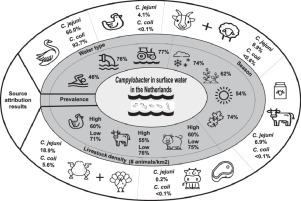Water Research ( IF 11.4 ) Pub Date : 2020-09-20 , DOI: 10.1016/j.watres.2020.116421 Annemieke C. Mulder , Eelco Franz , Sharona de Rijk , Moyke A.J. Versluis , Claudia Coipan , Ralph Buij , Gerard Müskens , Miriam Koene , Roan Pijnacker , Birgitta Duim , Linda van der Graaf-van Bloois , Kees Veldman , Jaap A. Wagenaar , Aldert L. Zomer , Franciska M. Schets , Hetty Blaak , Lapo Mughini-Gras

|
Campylobacter jejuni and C. coli, the primary agents of human bacterial gastroenteritis worldwide, are widespread in surface water. Several animal sources contribute to surface water contamination with Campylobacter, but their relative contributions thus far remained unclear. Here, the prevalence, genotype diversity, and potential animal sources of C. jejuni and C. coli strains in surface water in the Netherlands were investigated. It was also assessed whether the contribution of the different animal sources varied according to surface water type (i.e. agricultural water, surface water at discharge points of wastewater treatment plants [WWTPs], and official recreational water), season, and local livestock (poultry, pig, ruminant) density. For each surface water type, 30 locations spread over six areas with either high or low density of poultry, ruminants, or pigs, were sampled once every season in 2018-2019. Campylobacter prevalence was highest in agricultural waters (77%), and in autumn and winter (74%), and lowest in recreational waters (46%) and in summer (54%). In total, 76 C. jejuni and 177 C. coli water isolates were whole-genome sequenced. Most C. coli water isolates (78.5%) belonged to hitherto unidentified clones when using the seven-locus sequence type (ST) scheme, while only 11.8% of the C. jejuni isolates had unidentified STs. The origin of these isolates, as defined by core-genome multi-locus sequence typing (cgMLST), was inferred by comparison with Campylobacter strain collections from meat-producing poultry, laying hens, adult cattle, veal calves, small ruminants, pigs, and wild birds. Water isolates were mainly attributed to wild birds (C. jejuni: 60.0%; C. coli: 93.7%) and meat-producing poultry (C. jejuni: 18.9%; C. coli: 5.6%). Wild bird contribution was high among isolates from recreational waters and WWTP discharge points, and in areas with low poultry (C. coli) or high ruminant (C. jejuni) densities. The contribution of meat-producing poultry was high in areas with high density of poultry, springtime, agricultural waters and WWTP discharge points. While wild birds and poultry were the main contributors to Campylobacter contamination in surface water, their contribution differed significantly by water type, season, and local poultry and ruminant densities.
中文翻译:

空肠弯曲菌和大肠弯曲菌追踪动物对地表水污染的来源
空肠弯曲杆菌和大肠杆菌是全世界人类细菌性胃肠炎的主要病原,广泛存在于地表水中。几种动物源造成弯曲杆菌对地表水的污染,但到目前为止,它们的相对作用仍不清楚。在这里,空肠弯曲杆菌和大肠杆菌的流行率,基因型多样性和潜在的动物来源在荷兰对地表水中的细菌进行了调查。还评估了不同动物来源的贡献是否根据地表水类型(即农业用水,废水处理厂[WWTP]排放点的地表水和官方娱乐用水),季节和当地牲畜(家禽,猪,反刍动物)的密度。对于每种地表水类型,在2018-2019年每个季节采样一次,分布在六个区域的30个地点,高密度或低密度的家禽,反刍动物或猪。在农业用水中,弯曲杆菌的患病率最高(77%),在秋季和冬季(74%),而在休闲用水中,弯曲杆菌的患病率最低(46%),在夏季(54%)。总共有76个空肠弯曲菌和177个大肠杆菌对水分离物进行全基因组测序。使用七基因座序列类型(ST)方案时,大多数大肠杆菌水分离株(78.5%)属于迄今未鉴定的克隆,而空肠弯曲杆菌中只有11.8%的菌株具有未鉴定的ST。通过与产肉家禽,产蛋母鸡,成年牛,小牛,小反刍动物,猪和猪的弯曲杆菌菌株集合进行比较,可以推断出这些分离物的来源,如核心基因组多基因座序列类型(cgMLST)所定义。野生鸟类。水分离物主要归因于野生鸟类(空肠弯曲杆菌:60.0%;大肠杆菌:93.7%)和产肉家禽(空肠弯曲杆菌:18.9%;大肠杆菌):5.6%)。在娱乐水和污水处理厂排放点的分离物中,以及在低家禽密度(C. coli)或反刍动物密度(C. jejuni)的地区,野生鸟类的贡献很高。在高密度禽肉,春季,农业用水和污水处理厂排放点的地区,产肉禽类的贡献很高。尽管野生鸟类和家禽是造成地表水弯曲杆菌污染的主要因素,但它们的贡献因水的类型,季节,当地家禽和反刍动物的密度而有很大差异。











































 京公网安备 11010802027423号
京公网安备 11010802027423号